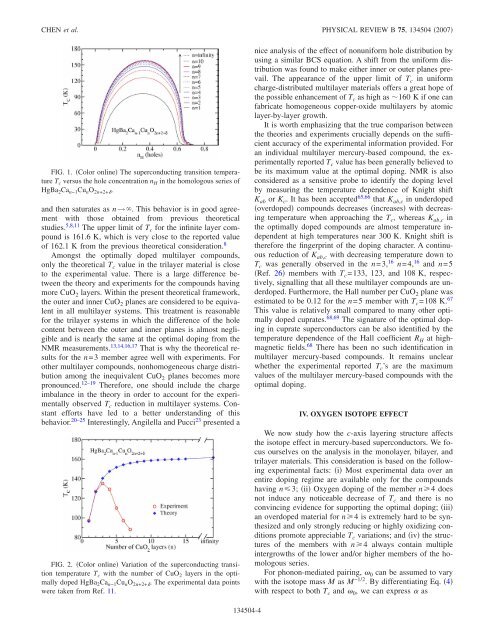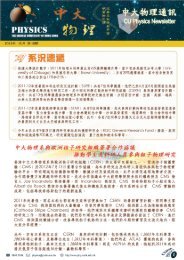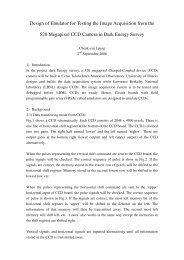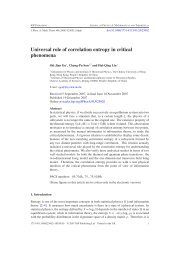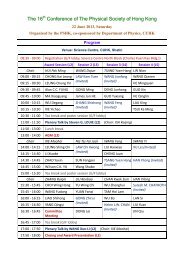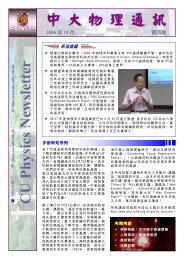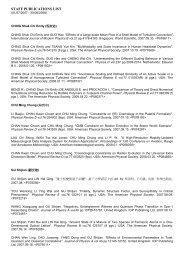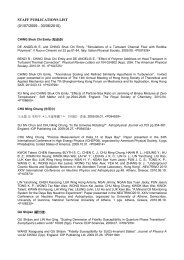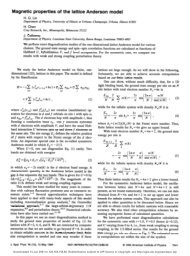Phonon-mediated superconducting transitions in layered cuprate ...
Phonon-mediated superconducting transitions in layered cuprate ...
Phonon-mediated superconducting transitions in layered cuprate ...
Create successful ePaper yourself
Turn your PDF publications into a flip-book with our unique Google optimized e-Paper software.
CHEN et al.<br />
FIG. 1. Color onl<strong>in</strong>e The <strong>superconduct<strong>in</strong>g</strong> transition temperature<br />
T c versus the hole concentration n H <strong>in</strong> the homologous series of<br />
HgBa 2 Ca n−1 Cu n O 2n+2+ .<br />
and then saturates as n→. This behavior is <strong>in</strong> good agreement<br />
with those obta<strong>in</strong>ed from previous theoretical<br />
studies. 5,8,11 The upper limit of T c for the <strong>in</strong>f<strong>in</strong>ite layer compound<br />
is 161.6 K, which is very close to the reported value<br />
of 162.1 K from the previous theoretical consideration. 8<br />
Amongst the optimally doped multilayer compounds,<br />
only the theoretical T c value <strong>in</strong> the trilayer material is close<br />
to the experimental value. There is a large difference between<br />
the theory and experiments for the compounds hav<strong>in</strong>g<br />
more CuO 2 layers. With<strong>in</strong> the present theoretical framework,<br />
the outer and <strong>in</strong>ner CuO 2 planes are considered to be equivalent<br />
<strong>in</strong> all multilayer systems. This treatment is reasonable<br />
for the trilayer systems <strong>in</strong> which the difference of the hole<br />
content between the outer and <strong>in</strong>ner planes is almost negligible<br />
and is nearly the same at the optimal dop<strong>in</strong>g from the<br />
NMR measurements. 13,14,16,17 That is why the theoretical results<br />
for the n=3 member agree well with experiments. For<br />
other multilayer compounds, nonhomogeneous charge distribution<br />
among the <strong>in</strong>equivalent CuO 2 planes becomes more<br />
pronounced. 12–19 Therefore, one should <strong>in</strong>clude the charge<br />
imbalance <strong>in</strong> the theory <strong>in</strong> order to account for the experimentally<br />
observed T c reduction <strong>in</strong> multilayer systems. Constant<br />
efforts have led to a better understand<strong>in</strong>g of this<br />
behavior. 20–25 Interest<strong>in</strong>gly, Angilella and Pucci 23 presented a<br />
FIG. 2. Color onl<strong>in</strong>e Variation of the <strong>superconduct<strong>in</strong>g</strong> transition<br />
temperature T c with the number of CuO 2 layers <strong>in</strong> the optimally<br />
doped HgBa 2 Ca n−1 Cu n O 2n+2+ . The experimental data po<strong>in</strong>ts<br />
were taken from Ref. 11.<br />
PHYSICAL REVIEW B 75, 134504 2007<br />
nice analysis of the effect of nonuniform hole distribution by<br />
us<strong>in</strong>g a similar BCS equation. A shift from the uniform distribution<br />
was found to make either <strong>in</strong>ner or outer planes prevail.<br />
The appearance of the upper limit of T c <strong>in</strong> uniform<br />
charge-distributed multilayer materials offers a great hope of<br />
the possible enhancement of T c as high as 160 K if one can<br />
fabricate homogeneous copper-oxide multilayers by atomic<br />
layer-by-layer growth.<br />
It is worth emphasiz<strong>in</strong>g that the true comparison between<br />
the theories and experiments crucially depends on the sufficient<br />
accuracy of the experimental <strong>in</strong>formation provided. For<br />
an <strong>in</strong>dividual multilayer mercury-based compound, the experimentally<br />
reported T c value has been generally believed to<br />
be its maximum value at the optimal dop<strong>in</strong>g. NMR is also<br />
considered as a sensitive probe to identify the dop<strong>in</strong>g level<br />
by measur<strong>in</strong>g the temperature dependence of Knight shift<br />
K ab or K c . It has been accepted 65,66 that K ab,c <strong>in</strong> underdoped<br />
overdoped compounds decreases <strong>in</strong>creases with decreas<strong>in</strong>g<br />
temperature when approach<strong>in</strong>g the T c , whereas K ab,c <strong>in</strong><br />
the optimally doped compounds are almost temperature <strong>in</strong>dependent<br />
at high temperatures near 300 K. Knight shift is<br />
therefore the f<strong>in</strong>gerpr<strong>in</strong>t of the dop<strong>in</strong>g character. A cont<strong>in</strong>uous<br />
reduction of K ab,c with decreas<strong>in</strong>g temperature down to<br />
T c was generally observed <strong>in</strong> the n=3, 16 n=4, 16 and n=5<br />
Ref. 26 members with T c =133, 123, and 108 K, respectively,<br />
signall<strong>in</strong>g that all these multilayer compounds are underdoped.<br />
Furthermore, the Hall number per CuO 2 plane was<br />
estimated to be 0.12 for the n=5 member with T c =108 K. 67<br />
This value is relatively small compared to many other optimally<br />
doped <strong>cuprate</strong>s. 68,69 The signature of the optimal dop<strong>in</strong>g<br />
<strong>in</strong> <strong>cuprate</strong> superconductors can be also identified by the<br />
temperature dependence of the Hall coefficient R H at highmagnetic<br />
fields. 68 There has been no such identification <strong>in</strong><br />
multilayer mercury-based compounds. It rema<strong>in</strong>s unclear<br />
whether the experimental reported T c ’s are the maximum<br />
values of the multilayer mercury-based compounds with the<br />
optimal dop<strong>in</strong>g.<br />
IV. OXYGEN ISOTOPE EFFECT<br />
We now study how the c-axis layer<strong>in</strong>g structure affects<br />
the isotope effect <strong>in</strong> mercury-based superconductors. We focus<br />
ourselves on the analysis <strong>in</strong> the monolayer, bilayer, and<br />
trilayer materials. This consideration is based on the follow<strong>in</strong>g<br />
experimental facts: i Most experimental data over an<br />
entire dop<strong>in</strong>g regime are available only for the compounds<br />
hav<strong>in</strong>g n3; ii Oxygen dop<strong>in</strong>g of the member n4 does<br />
not <strong>in</strong>duce any noticeable decrease of T c and there is no<br />
conv<strong>in</strong>c<strong>in</strong>g evidence for support<strong>in</strong>g the optimal dop<strong>in</strong>g; iii<br />
an overdoped material for n4 is extremely hard to be synthesized<br />
and only strongly reduc<strong>in</strong>g or highly oxidiz<strong>in</strong>g conditions<br />
promote appreciable T c variations; and iv the structures<br />
of the members with n4 always conta<strong>in</strong> multiple<br />
<strong>in</strong>tergrowths of the lower and/or higher members of the homologous<br />
series.<br />
For phonon-<strong>mediated</strong> pair<strong>in</strong>g, 0 can be assumed to vary<br />
with the isotope mass M as M −1/2 . By differentiat<strong>in</strong>g Eq. 4<br />
with respect to both T c and 0 , we can express as<br />
134504-4


